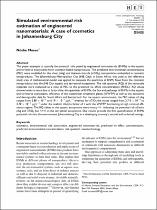 ResearchSpace
ResearchSpace
Simulated environmental risk estimation of engineered nanomaterials: a case of cosmetics in Johannesburg City
JavaScript is disabled for your browser. Some features of this site may not work without it.
- ResearchSpace
- →
- Research Publications/Outputs
- →
- Journal Articles
- →
- View Item
| dc.contributor.author |
Musee, N

|
|
| dc.date.accessioned | 2013-01-28T08:13:41Z | |
| dc.date.available | 2013-01-28T08:13:41Z | |
| dc.date.issued | 2011-09 | |
| dc.identifier.citation | Musee, N. 2011. Simulated environmental risk estimation of engineered nanomaterials: a case of cosmetics in Johannesburg City. Human and Experimental Toxicology, vol. 30(9), pp. 1181-1195 | en_US |
| dc.identifier.issn | 0960-3271 | |
| dc.identifier.uri | http://het.sagepub.com/content/30/9.toc | |
| dc.identifier.uri | http://het.sagepub.com/content/30/9/1181.full.pdf+html | |
| dc.identifier.uri | http://het.sagepub.com/content/30/9/1181.abstract | |
| dc.identifier.uri | http://hdl.handle.net/10204/6455 | |
| dc.description | Copyright: 2010 The author. This is the postprint version of the work. The definitive version is published in Human and Experimental Toxicology, vol. 30(9), pp. 1181-1195 | en_US |
| dc.description.abstract | This paper attempts to quantify the potential risks posed by engineered nanomaterials (ENMs) to the aquatic and terrestrial ecosystems from cosmetic-based nanoproducts. The predicted environmental concentrations (PEC) were modelled for the silver (nAg) and titanium dioxide (nTiO(2)) nanoparticles embedded in cosmetic nanoproducts. The Johannesburg Metropolitan City (JHB City), in South Africa, was used as the reference study area. A mathematical model was applied to compute the quantities of ENMs flows from the cosmetic nanoproducts into the JHB City aquatic and terrestrial ecosystems. The risk quotient (RQ) of the nanoscale materials were evaluated as a ratio of PEC to the predicted no effect concentrations (PNEC). RQ values showed wide variance due to factors like; the quantities of ENMs, the fate and pathways of ENMs in the aquatic and terrestrial ecosystems, efficiency of the wastewater treatment plants (WWTP) as well as the economic and demographic data for South Africa and Switzerland. For the aquatic environment, the PEC values of nAg ranged from 2.80 × 10(-3) to 6.19 × 10(-1) µg L(-1) whereas for nTiO(2) the values ranged from 2.7 0 × 10(-3) to 2.70 × 10(-1) µg L(-1) under the realistic dilution factor of 1 with the WWTP functioning at high removal efficiency regime. The RQ values in the aquatic ecosystems were mostly >1, indicating the potential risk of both nAg and nTiO(2) but <<<1 in the terrestrial ecosystems. Our results provide the first quantification of ENMs potential risk into the environment Johannesburg City in a developing country's natural and technical settings. | en_US |
| dc.language.iso | en | en_US |
| dc.publisher | SAGE Publications | en_US |
| dc.relation.ispartofseries | Workflow;7243 | |
| dc.subject | Cosmetics | en_US |
| dc.subject | Environmental risk assessment | en_US |
| dc.subject | Engineered nanomaterials | en_US |
| dc.subject | Predicted no effect concentrations | en_US |
| dc.subject | Predicted environmental concentrations | en_US |
| dc.subject | Risk quotient | en_US |
| dc.subject | Nanotechnology | en_US |
| dc.subject | Johannesburg City | en_US |
| dc.title | Simulated environmental risk estimation of engineered nanomaterials: a case of cosmetics in Johannesburg City | en_US |
| dc.type | Article | en_US |
| dc.identifier.apacitation | Musee, N. (2011). Simulated environmental risk estimation of engineered nanomaterials: a case of cosmetics in Johannesburg City. http://hdl.handle.net/10204/6455 | en_ZA |
| dc.identifier.chicagocitation | Musee, N "Simulated environmental risk estimation of engineered nanomaterials: a case of cosmetics in Johannesburg City." (2011) http://hdl.handle.net/10204/6455 | en_ZA |
| dc.identifier.vancouvercitation | Musee N. Simulated environmental risk estimation of engineered nanomaterials: a case of cosmetics in Johannesburg City. 2011; http://hdl.handle.net/10204/6455. | en_ZA |
| dc.identifier.ris | TY - Article AU - Musee, N AB - This paper attempts to quantify the potential risks posed by engineered nanomaterials (ENMs) to the aquatic and terrestrial ecosystems from cosmetic-based nanoproducts. The predicted environmental concentrations (PEC) were modelled for the silver (nAg) and titanium dioxide (nTiO(2)) nanoparticles embedded in cosmetic nanoproducts. The Johannesburg Metropolitan City (JHB City), in South Africa, was used as the reference study area. A mathematical model was applied to compute the quantities of ENMs flows from the cosmetic nanoproducts into the JHB City aquatic and terrestrial ecosystems. The risk quotient (RQ) of the nanoscale materials were evaluated as a ratio of PEC to the predicted no effect concentrations (PNEC). RQ values showed wide variance due to factors like; the quantities of ENMs, the fate and pathways of ENMs in the aquatic and terrestrial ecosystems, efficiency of the wastewater treatment plants (WWTP) as well as the economic and demographic data for South Africa and Switzerland. For the aquatic environment, the PEC values of nAg ranged from 2.80 × 10(-3) to 6.19 × 10(-1) µg L(-1) whereas for nTiO(2) the values ranged from 2.7 0 × 10(-3) to 2.70 × 10(-1) µg L(-1) under the realistic dilution factor of 1 with the WWTP functioning at high removal efficiency regime. The RQ values in the aquatic ecosystems were mostly >1, indicating the potential risk of both nAg and nTiO(2) but <<<1 in the terrestrial ecosystems. Our results provide the first quantification of ENMs potential risk into the environment Johannesburg City in a developing country's natural and technical settings. DA - 2011-09 DB - ResearchSpace DP - CSIR KW - Cosmetics KW - Environmental risk assessment KW - Engineered nanomaterials KW - Predicted no effect concentrations KW - Predicted environmental concentrations KW - Risk quotient KW - Nanotechnology KW - Johannesburg City LK - https://researchspace.csir.co.za PY - 2011 SM - 0960-3271 T1 - Simulated environmental risk estimation of engineered nanomaterials: a case of cosmetics in Johannesburg City TI - Simulated environmental risk estimation of engineered nanomaterials: a case of cosmetics in Johannesburg City UR - http://hdl.handle.net/10204/6455 ER - | en_ZA |





